The Garden Hose Incident - Or Why I Built My Own Overlanding Water Filter System
Our 42-litre rooftop tank seemed perfect, but we learned the hard way that not all water sources are safe. We needed a better system. Here's why I built my own portable water filtration solution.

Slovenia
The first real test for our overland equipment. We had a 42-litre plastic tank from Front Runner on the roof rack as our water source. Our camp spot was a meadow on private property with no running water and no toilet. We had to bring everything we needed with us – and it had to work.
Problem 1
Chemicals from the plastic tank leach into the drinking water, and this happens even faster at high ambient temperatures.
Problem 2
There's stale water in the tank and it's impossible to clean it with a small inlet. The only option is to give the tank a chemical clean, but then there might be residue left behind from the cleaning agent.
Problem 3
Refilling the tank is a bit of a pain and takes time without a pump. We realised that we needed a portable, reliable and robust solution to pump and filter water, which was easy to maintain and fix. I'm so excited to tell you about this amazing system! It can turn any type of water into clean, safe drinking water.
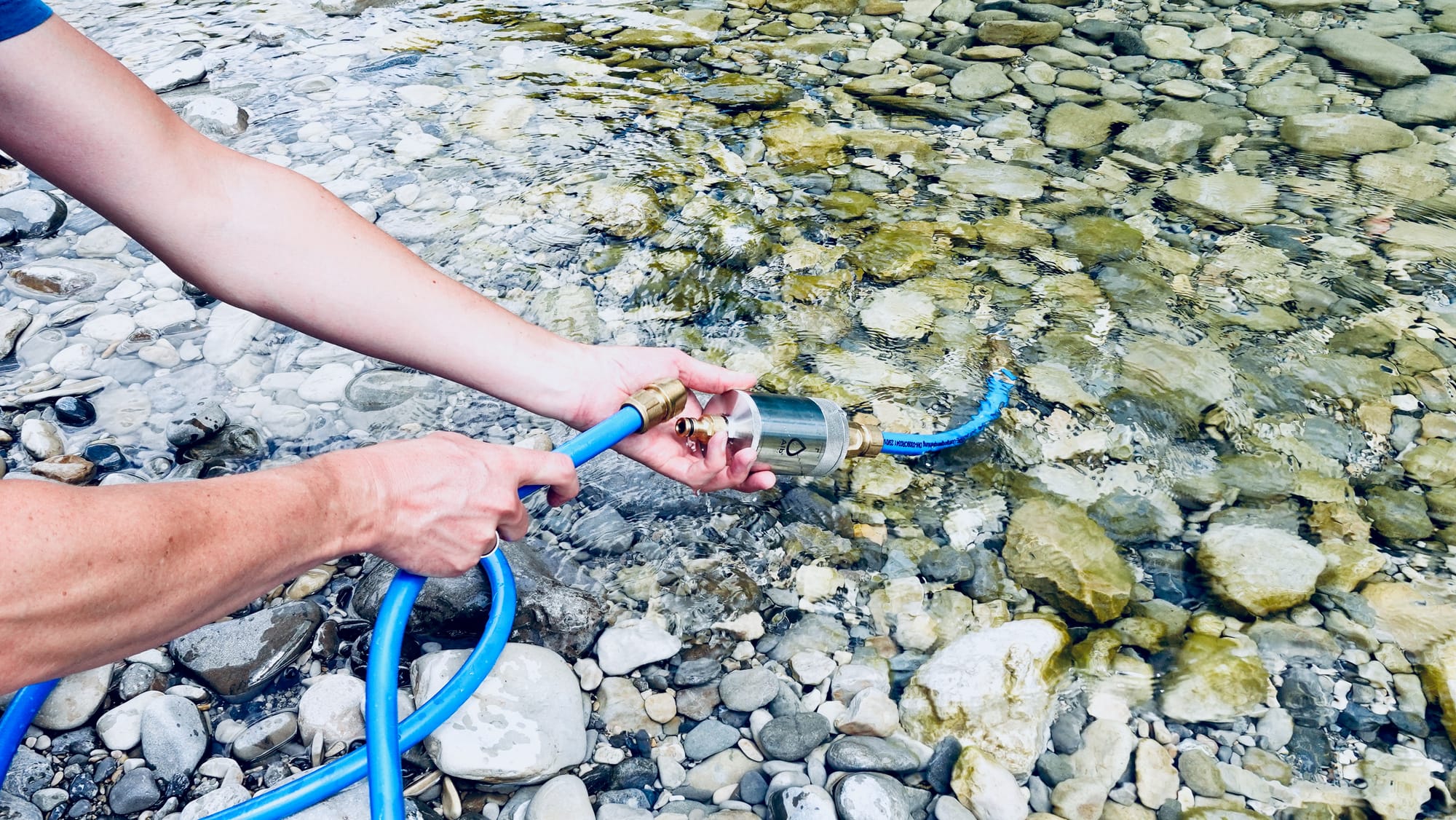
Drinking Water ≠ Drinking Water!
We had filled our water tank with drinking water previously and used silver ion tablets to prevent contamination. Contamination refers to the growth of germs in drinking water containers over a longer period of time. Although the water was drinkable at the time of filling, this does not mean that it will still be drinkable after a longer period of time in the container.
Two days later, our tank was almost empty, so we contacted the property owner to see if we could fill it up. "Sure, no problem." The owner had a house nearby where we stayed. At the house, we talked about the easiest way to fill up the 42-liter tank with water. We could take it down from the roof, fill it up with the garden hose, or use water bottles and walk 20 times to the kitchen. My idea was pretty straightforward: just use the garden hose, right? Wrong! It looks like the water from the kitchen sink was drinking water, but the water from the garden hose was not.
If you don't know this and fill up your tank without thinking twice, it can have serious consequences. Fortunately, the owner pointed this out to us.
At that moment, I realised: we didn't need better luck. We needed a better system. Our system was very simple and not at all safe.
If you're not sure about the water source, it's better not to take any risks. Your own health is the most important thing and you can't make any wrong decisions. So, when it comes to your health, it's best not to just guess. You need to be 99.999% sure. If you've got dirty water, it can ruin your holiday – or even worse! These pathogens can be pretty risky for your health.
Main Risks & What You Can Do About It
A) Bacteria
Types: E. coli, salmonella, legionella, campylobacter
Size: 0.5 - 3 µm
Risk: High - diarrhea, vomiting, possible death

B) Viruses
Types: Hepatitis A, norovirus, rotavirus
Size: 0.02 - 0.1 µm (VERY small!)
Risk: High - Liver inflammation, severe gastrointestinal issues

C) Protozoa
Protozoa are single-celled microorganisms that are significantly larger than bacteria (typically 2-50 micrometers). They occur naturally in surface water—in lakes, rivers, streams, and even in contaminated drinking water.
Types: Giardia lamblia, Cryptosporidium, Entamoeba histolytica
Size: 4 - 30 µm
Risk: Severe diarrhea, can be life-threatening
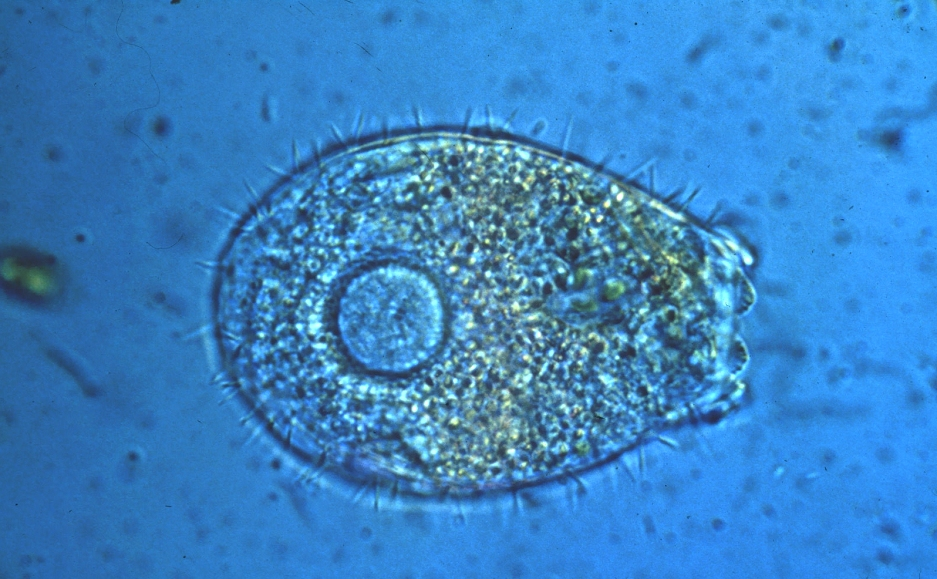
In another article, I am discussing water health issues in detail, explain which filters are safe to use when travelling, which system we use, and how you can replicate it.
It’s not just bacteria, viruses, or protozoa that can harm your health — even the materials your cookware, water tank, or pans are made from can slowly release substances that affect your body over time.
Aluminum, microplastics, and PFAS (found in non-stick coatings like Teflon) are among the most well-known culprits. But in reality, every type of plastic contains a range of chemical additives that can leach into your food and drinking water.
That’s why we decided to part ways with our plastic water tank and switch to a stainless steel tank for our drinking water on the road.
Our old setup was problematic because:
- heat and sunlight could cause chemicals to leach from the plastic,
- biofilms and bacteria easily formed on the inner surfaces,
- cleaning was difficult and never truly residue-free,
- and over time, the water developed a faint plastic taste and smell.
With the new stainless steel tank, we now have a system that’s not only more durable and hygienic but also gives us peace of mind — especially when it comes to the health of our family.
- 42-litre plastic water tank (plasticiser)
- Silver ions for conservation (only works on bacteria) and what hat about viruses?
- No filters. Water quality varies greatly from region to region, and especially after storms, sewage treatment plants are overloaded and drinking water is additionally chlorinated.
This means that with our current system, we could only fill up with drinking water and had to be sure that it was indeed drinking water:
- Only ‘official’ drinking water can be used
- Water quality in Europe = a lottery
- Chemicals from plastic in the water
- Zero protection against viruses
- Constant worry: ‘Is this really clean?’
- Chlorinated water can still contain viable (infectious) Protozoa - especially Cryptosporidium
Such a system works quite well for a weekend trip. But does it also work for a three-week off-grid trip through Spain? No!
Now what? I started developing my own solution ...
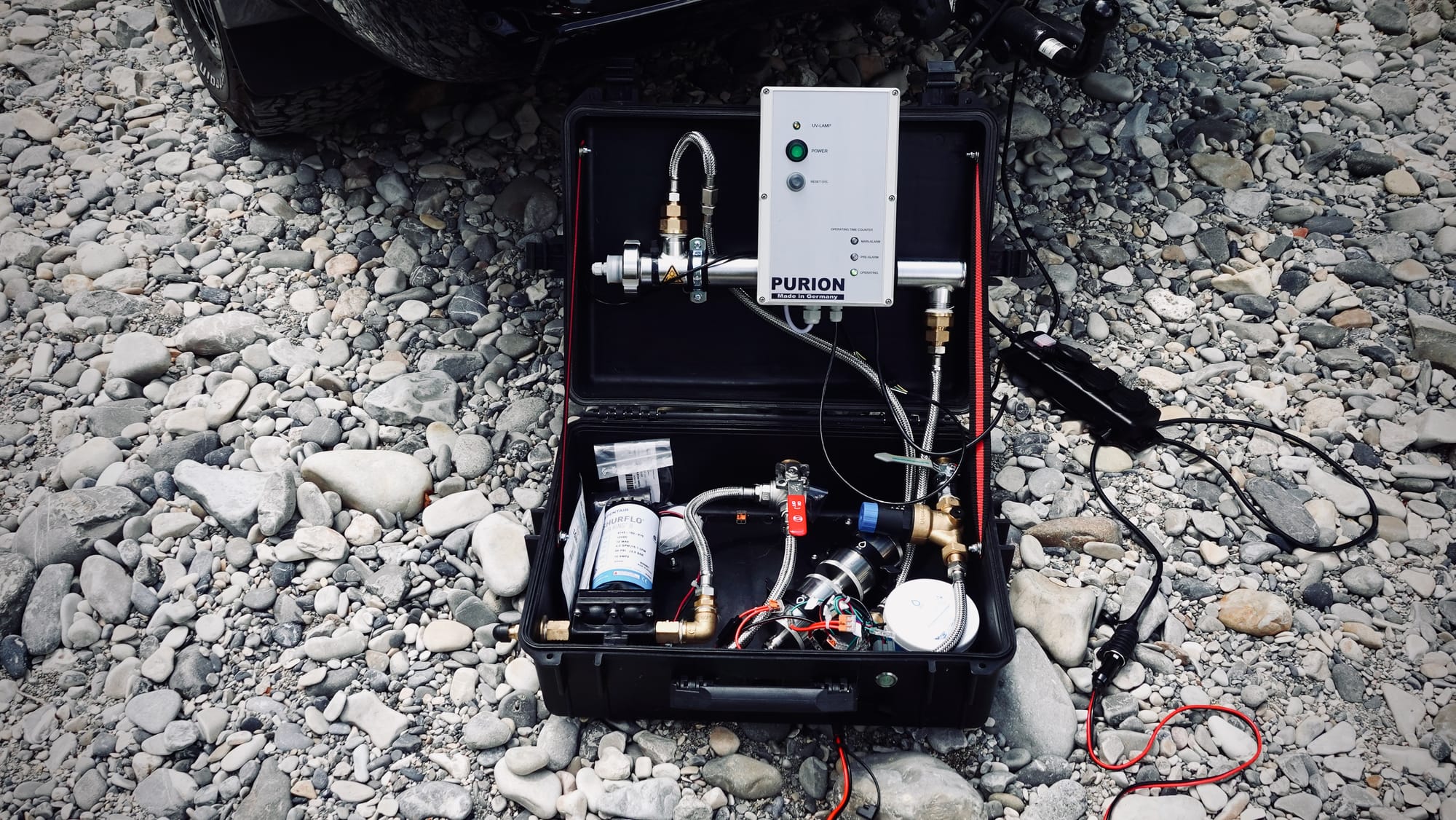
Engineering A Portable Solution
This solution had to be compatible with any water source and be able to handle two different scenarios: 1) filling the tank & 2) producing safe drinking water. I needed to define what a serious system needs to offer. In this article you can learn more about water filtration.
- Stainless steel tank (metal instead of plastics)
- Sediment filter (removes dirt, rust and particles, needed to protect the filters and for the UV unit to work properly)
- Activated carbon (keeps the stainless steel tank clean)
- Membrane pump
- Additional activated carbon (removes chlorine, pesticides and taste)
- 0.1 µm nanofilter (removes bacteria & protozoa, coliforms and microplastics)
- UV sterilisation (deactivates viruses – physically guaranteed)
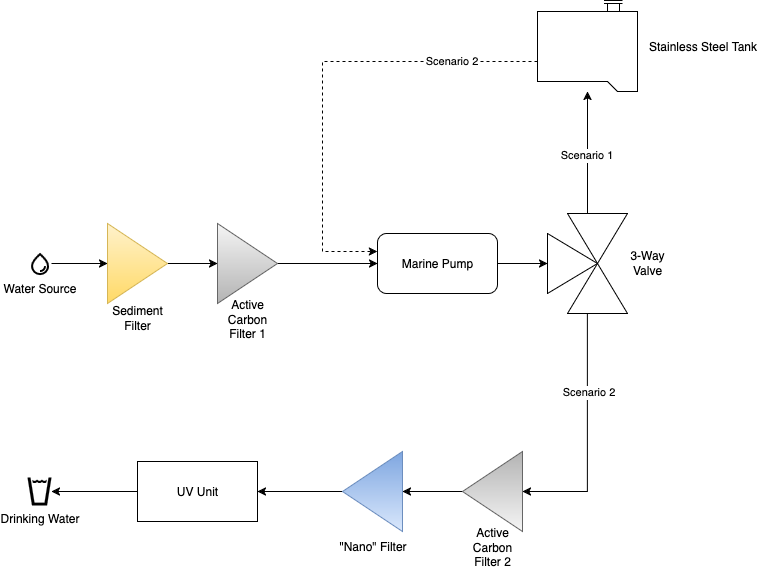
After four weeks of intensive development and research, I had my first portable pump case with a multi-stage filtration system.
Available December 2025 — Register now for early access!
The first professional, field-tested guide to building a safe overlanding water system.
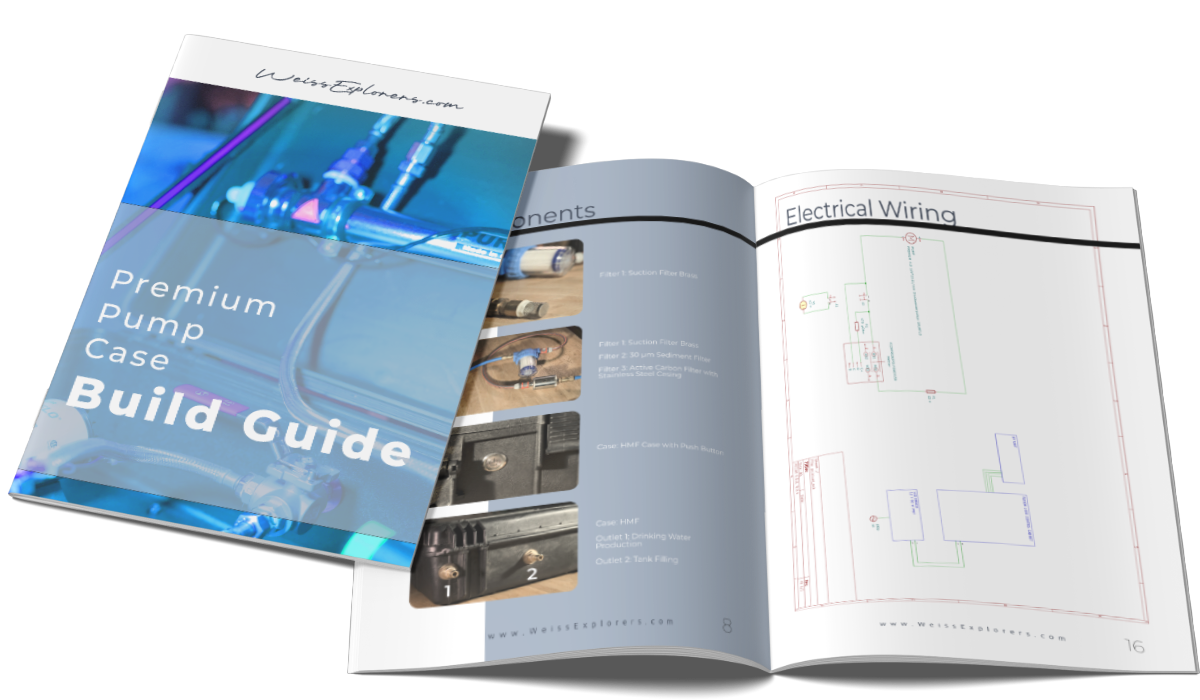
Subscribers will be notified first when the guide is released.
We had an amazing time testing this system out in the wild Pyrenees! We tried it out in both scenarios: filling the tank and producing drinking water.
We learned that there are a few things to be improved, e.g. the pre-filter from Alb Filter cannot be used in this setup. The paper filter causes a huge pressure drop which the membrane pump cannot comprehend with a air filled hose. Therefore, we are currently testing a 30 µm sediment filter from Pentair as protection for the activated carbon filter. Soon, I will upload a quick video from the test with this new filter! Hopefully this works better in the suction pipe due to a lower pressure drop.
In this article I am writing in detail about other harmful substances found in surface water and which may also be present in water from domestic water connections. Read more about water filtration basics and why clean water is important while being on the road!
If you're interested in building your own portable pump case with a multi-stage filtration and UV sterilisation unit, check out the PDF blueprint below!
Already a Member? Download the Pump Case Blueprint here.
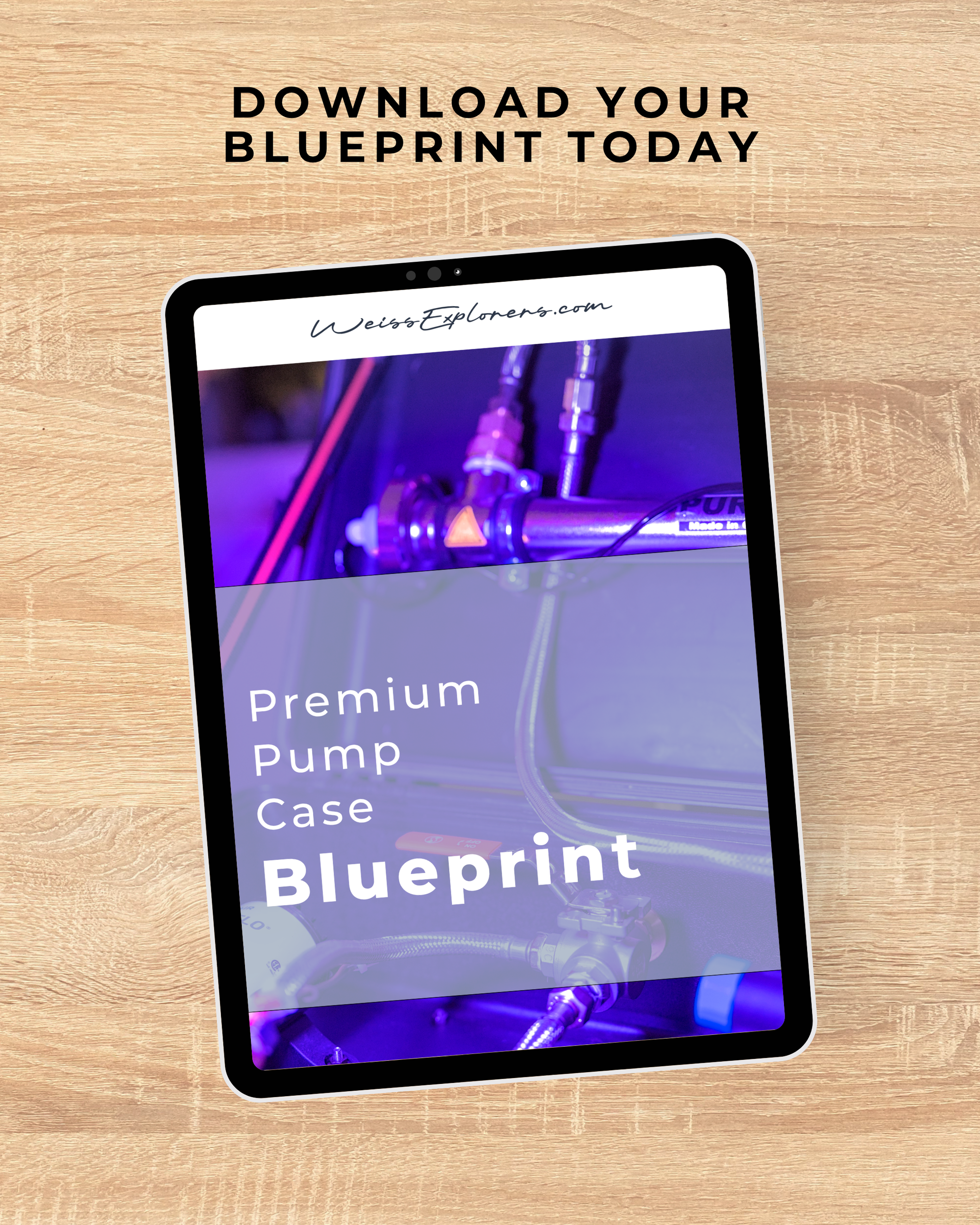
Sign up to download your free PDF blueprint of the pump case with multi-stage filtration for your next overlanding adventure & start to build your own system today!
